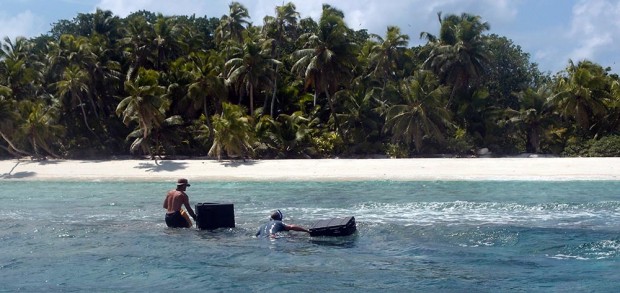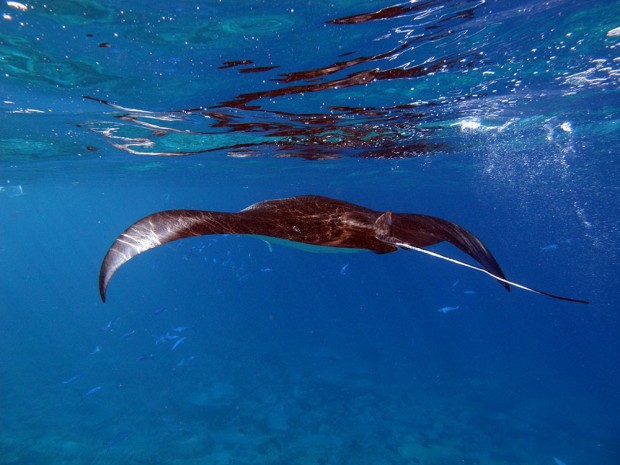2015 Darwin Science Expedition - Day 10 - The Coquillages…

Peros Banhos Petit Ile Coquillage Blog
The Coquillages threw up some treats today – for the terrestrial crew there were tours around these pristine tropical islands. Complete with hardwoods and grasslands and oodles of nesting and roosting seabirds. We took the Trekker around Petit Ile Coquillage and the interior of the island is a steady grassland interspersed with copses of coconut palms and patches of scaevola and clumps of hardwood. Look forward to seeing this one on street view.

In the water the team split between Grand Coquillage, where Nick and Shaun pursued there connectivity studies between island vegetation and wildlife and reef nutrients. The remainder of us headed to the Oceanside of Petit Coquillage where we encountered some beautiful and rich marine life. In a short snorkel and an hours dive I encountered 5 turtle and 3 octopus amongst myriad fish species. Whilst waiting on the surface for the remainder of the divers to come up several manta wafted by beneath us clearly visible in the crystal water. One of the dive boats encountered five or so more of these big winged wonders on the short boat ride back to the research vessel.

So another beautiful and successful day on this Darwin Science Expedition. This is our last stop in Peros Banhos Atoll...as we wrap up here and move on it is a good opportunity to give you more detail on the work that Chris and Gary are doing out here.
How fast are coral reefs growing in the Chagos Archipelago
Chris Perry & Gary Murphy, University of Exeter
Coral reefs are experiencing an unprecedented decline in their abundance, diversity, and habitat structures. These changes are not only impacting upon reef ecology, but also now are starting to change the amounts of calcium carbonate that are being produced and eroded on reefs, calcium carbonate being the material that coral skeletons and reef sands are made of. This is an especially critical issue because the balance between the amount of carbonate that is produced and eroded (what we term a ‘carbonate budget’) has a major impact upon the rate at which a reef can grow and on the ability of reefs to maintain their complex surface structures. We measure these biological carbonate budgets through detailed surveys of corals and other calcareous organisms, such as coralline algae, and surveys of the abundances of parrotfish, urchins and other biological eroders that collectively break down the substrate. The overall balance between the amount of production and erosion thus provides us with a measure of reef “health” from a reef growth perspective. Whilst work on reef budget states, from various heavily degraded sites in the Caribbean, is now emerging, we have very little understanding of reef carbonate budget states from sites that are relatively remote from major human disturbance. Few areas of the world offer the possibility to examine such issues, but Chagos is one of these.
Diego Garcia

Our field surveys started on the reefs surrounding Diego Garcia, and we have spent the last 3 days working on a number of reefs around the northern and north-western sides of the atoll. Compared to many reefs we have studied recently in the Caribbean these have what appear to be relatively thriving and diverse coral communities within our target habitats (~10 m depth), with the coral communities typically dominated by the branching corals Acropora and Pocillopora, and the mound coral Porites. Our initial estimates suggest positive carbonate budget states at all sites (meaning that rates of carbonate production exceed rates of biological erosion) and with coral cover and carbonate budget states about 50% higher than the averages calculated from multiple sites across the Caribbean. Interestingly, however, we note variable evidence of active reef structural development at these sites, with the corals often growing on older limestone surfaces. The reefs around these areas of Diego Garcia are, however, quite narrow and relatively steeply sloping and our assumption is that a significant amount of the coral substrate that is produced is periodically stripped off during storms and lost into deeper water. Nonetheless, given the proximity of these reefs to the only inhabited island in the Chagos Archipelago, and given that coral populations have been hit in recent years by bleaching and disease events, these numbers are impressive. We await with excitement to see what the more remote atolls are like.

Peros Banhos
An overnight steam has brought us to the large and beautiful Peros Banhos atoll, with the boat initially moored up in the south-west corner allowing us to access a range of reefs along the relatively more sheltered western side. We were told that the sites on the seaward side of Ile Poule, Ile Anglaise and Ile Fouquet were stunning and so this proved. Wonderful clear waters and the reefs covered in large table-like and branched colonies of Acropora and a myriad of other mound, branched and encrusting species.

Immediately obvious to us also were the large numbers of very large parrotfish, a key grazer of algae on reefs and an important eroder of the substrate – parrotfish scraping and removing thin layers of coral skeleton as they search for algae.


This activity not only helps to keep a reef “healthy” and free from weedy algae, but also results in the generation of large amounts of sand – the fish excreting this in huge amounts once it has been processed in their stomachs. A large amount of the sand on the beaches and in the islands is likely derived from this parrotfish feeding.

Next stop were sites in the north-west of Peros Banhos, with surveys conducted on the seaward sides of Ile Diamant and Ile de la Passe. Again, impressive sites with good coral cover and abundant parrotfish populations, but perhaps the most impressive dive was to survey the lagoon reefs inside Ile Diamont, a stunningly complex reef surface provided by the high cover of branching Acropora corals and, most especially the large platy whorls of the coral Echinopora. A great dive.
Our final stop in Peros Banhos was on the eastern side of the atoll, with a chance to work on two “exposed” reefs at Petite Coquillage and Grand Coquillage. These two reefs were visually very different and dominated by mound shaped Porites colonies and robust branched Pocillopora. Parrotfish numbers were also again high and we observed a large school of about 70 Greenthroat Parrotfish busily grazing across areas of large dead table Acropora.
VIDEO https://www.youtube.com/watch?v=MX_WzSYJ-RE
What can we say about the Peros Banhos reefs? Well carbonate production and bioerosion rates were both higher than on the reefs we visited around Diego Garcia, with overall carbonate budgets about 50% higher again and with net budget states close to double those measured at equivalent depths in the Caribbean – this despite all of these reefs being in various stages of post-disturbance recovery. Even more encouraging is that there is evidence of widespread coral recruitment and of the active growth of new corals from multiple coral recruitment events, which suggests the potential for rapid increases in carbonate production rates over the next few years. We leave now for Salomon Atoll ….

